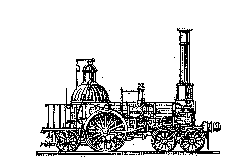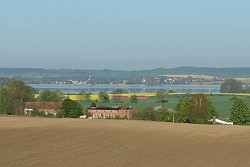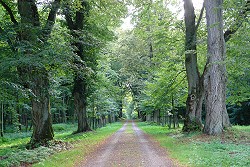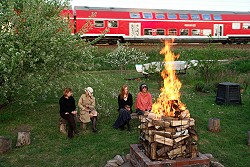

If you are travelling from Berlin via Angermünde to Stralsund or vice verse, you will not be able to extract yourself from the charm of the park landscape with the Ucker lakes and the long distance sights on towns and buildings. Sometimes travelling by rail creates completely an unexpected fascination.
The designed region commences at Angermünde. Important features, like the garden kingdom Dessau-Wörlitz, became the model and provided an inspiration for the networks of the younger facilities around Potsdam and Berlin.
The uckermärkische park landscape is not just a pale copy of the Potsdam facilities. The development was more economically orientated, meaning more modern. Peter Joseph Lenné and his work partners were are to build on important preconditions, e.g. previous landscape designs in conjunction with economic reforms on the estates.

At the park landscape between Angermünde and Prenzlau the rail track itself is an object of design as well as a means for presentation. The design focuses particularly on the travel experience. Through a generous segregation one recognised the reduced ability seeing the landscape which is caused by the speed of the train. There are no historical hedges, which can create quite disturbing view barriers when travelling by rail.
The actual „rediscovery“ of the park landscape by rail started in 1994 at the survey of the monument of the park of Görlsdorf.
Three designs of Lenné zu Görlsdorf are preserved. In the main design dated 1829, drawn by Gerhard Koeber, he already recognises the future rail track Berlin-Stettin and Berlin-Angermünde-Stralsund.

The park landscape developed in three clearly separated steps, jointly with the planning and construction of the rail track from Angermünde to Prenzlau.
The railway and the linked park landscape were designed and built in a period of more than 30 years in a creative process of proximity and contradiction.

First step: The contruction of the track via Angermünde to Stralsund was uncertain for a long time. In oder to ensure the rail connection for Prenzlau, it was consedred to possibly using rail branches. The planning position of 1830 at Görlsdorf assumes, that the park landscape was already partially decided.
Second step: The completion of the railway Berlin-Stettin in 1843 triggered an intensive building activity. Due to the extension, redesign and linking of existing park landscapes like in Suckow, the foundations for the later built park landscapes as art work were created.
Third step: In November 1853 the king finally agreed to the building of the railway. In 1854 the last project of a railway branch via Gramzow to Passow was declined. Stralsund deferred the building of the northern railway due to significant difficulties and participated in the building of the track through the Uckermark. In 1863 the construction was completed by the Berlin-Stettiner Railway company.
